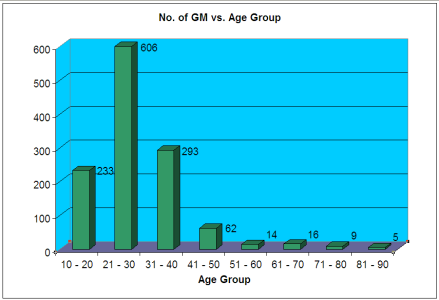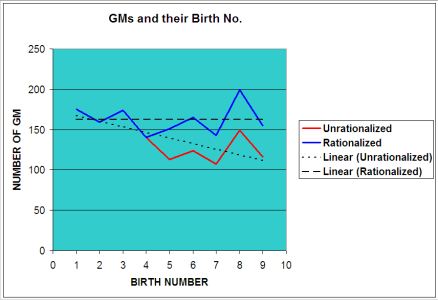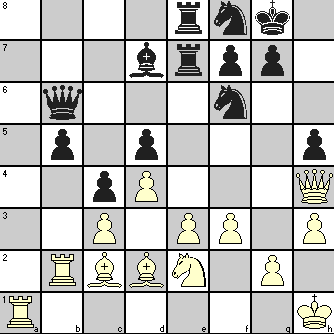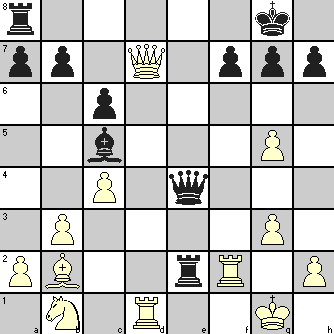It takes a lot of effort in searching for suitable content, collecting information, and finally creating and editing the article for putting it up on the blog site. All this effort gets its reward when readers come out with their comments which shows firstly, that they have read it and secondly, that they felt something about it! We are thankful to the readers who write back for another reason also: their views and comments give us ideas for fresh articles and these help to sustain the cycle.
The idea for the present article came from the comments of two readers on two different topics.
Reader Ralphe commented on Chess Trivia: What the List of Grandmasters reveal by saying “I wonder why Vishy is not in the list, he was pretty young when he got his GM as well.” We clarified to him why Vishy was not on the list, but that set our thoughts to write some article using one of his games when he was pretty young. But which aspect should we consider as a theme for our article?
Here we came to remember what reader Chess king had to say on Chess Sacrifice as a Chess Tactics: to seize initiative. He brought us the quote from GM Bent Larsen: “The stomach is an essential part of the Chess master”. So why not show that Viswanathan Anand, more popularly known as ‘Vishy’ in chess circle, had it in him even when he was barely 16!
This game we have chosen was played in London in 1985 when Vishy was still an IM and his opponent Mestel was a GM.
Viswanathan ‘Vishy’ Anand (b.1969) became an IM in 1984 at the age of 15. He won the Indian Championship in 1985 and World Junior Championship in 1987. He became the first GM from India in 1988. He became FIDE World Champion in 2000 and proved his undisputed ability in the rapid play version of the game by becoming 2003 FIDE World Rapid Chess Champion. In 2006, he became only one of the four players ever to cross FIDE Elo rating of 2800 (others are Kasparov, Kramnik and Topalov). After FIDE was reunited in 2006, Anand became the undisputed World Champion in 2007 by winning the double round robin tournament held by FIDE with 8 top players (Kramnik – reigning champion, Anand, Gelfand, Leko, Svidler, Aronian, Morozevich, Grischuk) of the time with the exception of Topalov. He successfully retained the title in 2008 by defeating Kramnik in the older format of match play between Holder and Challenger. He is the current World Chess Champion.
Note: As compensation for being denied entry to the 2007 tournament, Topalov was given some special privileges by FIDE by which, after defeating Gata Kamsky in February 2009, he is the new challenger against Anand for World Championship Match to be held later this year
Andrew Jonathan Mestel (b.1957) of UK was World Under-16 Champion in 1974 and became an IM in 1977 and GM in 1982.
The diagram shows position after 18 moves.
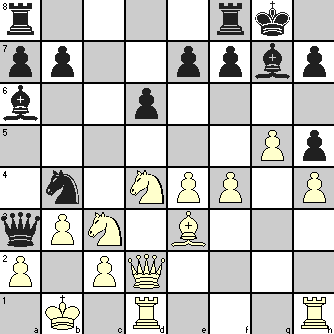
| 19. | Nf5 | Rfe8 | if 19. … Bxc3 then 20. Qxc3 Qxa2+ 21. Kc1 and any idea of Black bringing pressure on White Queen and c2 square by Rac8 fails due to White’s threat of Qg7# and trying to counter that allows White Queen to capture the Knight at b3 | |
| 20. | Nxg7 | Kxg7 | ||
| 21. | Qd4+ | e5 | This move of Black was an error because in trying to guard against one line, he exposed himself in another as White proved soon | |
| 22. | Qxd6 | Rac8 | In trying to create his own threats, Black overlooked what White had in mind | |
| 23. | Qf6+ | Kg8 | After Black’s previous move, White was aware that once Black got time to play Rxc3 to remove his defender knight, his King would be two moves away from a mate starting with Black’s Qxa2+. He had to be sure of retaining his tempo against that threat at the back of his mind and this showed that he had the stomach for it! | |
| 24. | Rd7 | Rf8 | White was threatening mate in two against Black’s mate in three! | |
| 25. | g6 | Resigns | 25. … fxg6 was obviously out because of 26. Qg7#, but other alternatives do not provide any respite. For example: 25. … hxg6 26. Rg1 with threat of 27. Rxg6+ followed by mate next move irrespective of Black’s response 25. … Rxc3 26. gxf7+ Rxf7 27. Qxf7+ Kh8 Qh7# |
The position after White’s 25th move is shown below.
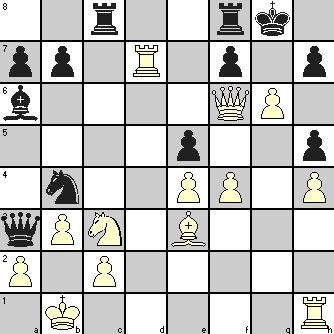
So you see how Vishy kept his nerve to always remain one step ahead of Black’s threats working on the principle of attack being the best defense!
Watch the Game
httpv://www.youtube.com/watch?v=HTT5VULbRxA
